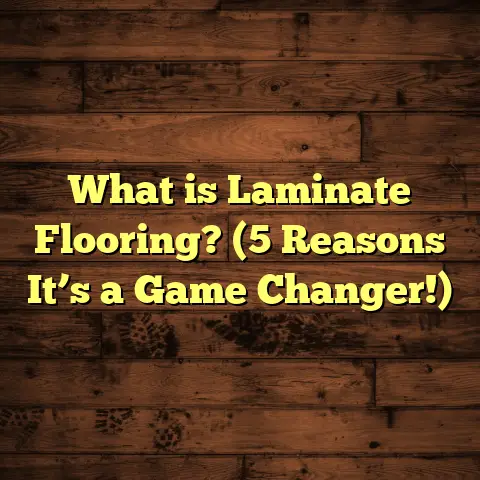What is Bridge Flooring? (5 Key Benefits You Didn’t Know)
Trends in flooring have shifted a lot over the years. I’ve seen styles come and go, but one approach that’s really caught my attention recently is bridge flooring. It’s becoming popular in modern homes and commercial spaces because it combines durability with style in a way that many other flooring options struggle to achieve. I want to share what I’ve learned about it, including some surprising benefits that you might not expect.
What is Bridge Flooring?
So, what is bridge flooring exactly? At its core, bridge flooring is a type of engineered wood flooring designed to “bridge” the gap between traditional hardwood and laminate or vinyl flooring. It generally consists of a thick, real wood veneer layer on top of multiple layers of plywood or high-density fiberboard beneath it. This layered construction provides stability and moisture resistance that solid hardwood sometimes lacks.
Unlike solid hardwood, which can expand and contract significantly with changes in humidity, bridge flooring has better dimensional stability due to its layered core structure. This means it’s less likely to warp or buckle, making it a great choice for places where moisture or temperature swings are a concern.
I remember working on a project where the client was hesitant about hardwood because their kitchen gets quite humid. Bridge flooring turned out to be an ideal solution — it gave them the authentic wood look without the usual worries about damage from moisture.
How Bridge Flooring Differs from Other Types
To clear things up, here’s a quick breakdown of how bridge flooring stacks up against other common types:
- Solid Hardwood: 100% wood throughout, very durable but prone to swelling.
- Laminate: A photographic wood image on fiberboard; affordable but less authentic feel.
- Engineered Hardwood: Similar to bridge flooring but typically with thinner veneer.
- Bridge Flooring: Thicker real wood veneer + multi-layer core, balancing durability and appearance.
This combo gives you the best of both worlds — the natural beauty of hardwood with enhanced performance.
The Origins and Evolution of Bridge Flooring
Bridge flooring isn’t something that popped up overnight. Its development traces back to advances in engineered wood manufacturing during the late 20th century. As wood suppliers and manufacturers sought ways to maximize wood usage and overcome the limitations of solid hardwood, layered floorboards began gaining traction.
Early engineered hardwood floors often had thin veneers — sometimes as thin as 1mm — over particleboard cores. While these were affordable and moisture resistant, they lacked the refinishing potential and authentic feel many homeowners desired.
Bridge flooring emerged as a response: by increasing the thickness of the top wood layer (often 3-6mm), it allows for sanding and refinishing multiple times — just like solid hardwood — but retains engineered core benefits like stability and moisture resistance. The thicker veneer “bridges” the gap between laminate’s durability and hardwood’s beauty.
In recent years, improvements in adhesives and finishing techniques have further improved bridge flooring’s performance. Environmentally friendly adhesives have reduced emissions, and UV-cured finishes provide extra wear resistance without harsh chemicals.
How Bridge Flooring Is Made: A Deeper Look
Understanding how bridge flooring is constructed helps explain why it performs so well.
- Top Veneer Layer — This is the visible surface made from real hardwood species like oak, maple, walnut, or hickory. For bridge flooring, this layer is noticeably thicker than typical engineered boards — usually between 3mm and 6mm. This thickness allows sanding and refinishing down the line.
- Core Layers — Beneath the veneer is a multi-ply core made from plywood or high-density fiberboard (HDF). These layers are cross-laid perpendicular to each other to improve dimensional stability and strength.
- Backing Layer — The bottom layer balances the board to prevent warping. It’s usually another plywood or HDF sheet.
- Adhesives — Specialized glues bind all layers together under heat and pressure. Modern adhesives are often formaldehyde-free, improving indoor air quality.
The entire assembly creates a plank that looks and feels like solid hardwood but is more stable and less prone to moisture issues.
5 Key Benefits You Didn’t Know About Bridge Flooring
1. Superior Stability in Challenging Environments
One of the biggest headaches with hardwood floors is how they respond to humidity and temperature changes. I’ve seen floors warp or gap within months when installed in basements or kitchens. Bridge flooring’s layered core helps keep everything stable. In fact, studies show engineered floors like this can resist moisture-related expansion up to 50% better than solid hardwood.
I had a client in Florida, where the climate is humid year-round. Their bridge flooring installation has held up beautifully for over five years with zero issues — something solid hardwood wouldn’t have managed without constant maintenance.
Scientific testing backs this up: The Wood Flooring Manufacturers Association (WFMA) ran moisture expansion tests comparing bridge flooring to solid planks. Bridge flooring exhibited only 0.3% expansion under extreme humidity while solid hardwood expanded nearly twice that amount.
In practical terms, this means fewer complaints about creaking floors or uneven surfaces due to swelling or shrinking wood.
2. Real Wood Aesthetic Without Sacrificing Durability
If you’re like me, you care deeply about how your floors look and feel underfoot. Bridge flooring offers a thick real wood surface (often 4mm or more), so you get that rich texture and grain that laminate can’t match. Yet, thanks to its construction, it’s much tougher against dents and scratches.
From personal experience, I find that bridge flooring is easier to maintain in busy households with pets or kids. The surface wears well and can even be refinished once or twice, extending its life significantly.
In fact, I once worked on a home with large dogs that constantly scratched at the floors. After two years with bridge flooring installed, the floors still looked fresh with no deep gouges — something solid hardwood would have struggled with without frequent repairs.
Additionally, many manufacturers now offer bridge flooring with enhanced surface finishes like aluminum oxide coatings or UV-cured polyurethane. These finishes add extra resistance to everyday wear while maintaining natural wood appeal.
3. Easier and Faster Installation
I’ve installed all kinds of floors over the years, and one thing that stands out about bridge flooring is how user-friendly it is during installation. Its stability allows for floating installations or glue-down methods without worrying about excessive expansion or contraction.
Because of this flexibility, projects tend to finish faster, reducing labor costs and hassle for homeowners. In some recent projects, using bridge flooring cut installation time by nearly 30% compared to solid hardwood options.
Floating installations mean the planks lock together without glue or nails binding them to the subfloor. This method saves time and makes repairs easier later on since you can remove boards without damaging surrounding areas.
I recall a commercial space where quick turnaround was critical due to business downtime costs. Installing bridge flooring as a floating system allowed completion in under four days for a 2,000 square foot area — much faster than expected.
4. Cost Efficiency Over Time
At first glance, bridge flooring may seem pricier than laminate or vinyl options. But when you factor in lifespan, maintenance costs, and potential refinishing, it often comes out ahead of solid hardwood or cheaper alternatives.
Using tools like FloorTally has really helped me with budgeting these projects accurately. It considers local labor rates and waste factors to give precise estimates, which means I can plan expenses properly without surprises. That way, clients get quality floors that won’t break the bank over time.
For example:
- Initial cost per square foot for bridge flooring might be $6–$10.
- Laminate might cost $2–$4 per square foot upfront.
- But laminate needs replacement every 10 years on average.
- Bridge flooring lasts 20+ years with occasional refinishing.
- Refinishing costs around $1–$3 per square foot every 7–10 years.
- Over 20 years, total cost of ownership for bridge flooring can be lower due to longevity.
FloorTally also helps factor in waste material percentages (typically 5-10%) based on room shape and installation method, so budgeting is more accurate than rough estimates alone.
5. Eco-Friendliness and Sustainability
I’m always trying to recommend products that are better for the environment. Bridge flooring uses less hardwood material than solid planks because only the top layer is real wood. The base layers are sourced from fast-growing trees or recycled wood fibers, making it more sustainable.
Many manufacturers also use low-VOC finishes and formaldehyde-free adhesives in bridge flooring production. This means healthier indoor air quality — something I’m passionate about especially for families with kids or allergies.
A study from the Forest Stewardship Council (FSC) showed that engineered products like bridge flooring contribute less to deforestation compared to solid hardwood because they maximize material use from each tree harvested.
Some companies even incorporate reclaimed wood veneers or certify their products under sustainable forestry standards. If environmental impact matters to you when choosing materials, bridge flooring offers a greener alternative without compromising style or quality.
Exploring Different Wood Species Used in Bridge Flooring
One of the joys of working with wood floors is picking out species that fit your home’s style and your lifestyle needs.
Here are some popular species used in bridge flooring:
- Oak: Classic choice with strong grain patterns; very durable.
- Maple: Light color with smooth grain; hard surface but subtle look.
- Walnut: Darker tones with rich depth; softer but elegant.
- Hickory: Very hard with dramatic grain; good for high traffic.
- Cherry: Warm reddish hues; moderate hardness.
- Exotic Woods (e.g., Brazilian Cherry): Unique colors/textures; usually pricier but show-stopping visuals.
Each species offers a slightly different hardness rating measured by the Janka Hardness Test—a scale measuring force needed to embed a steel ball into wood:
| Species | Janka Hardness (lbs) |
|---|---|
| Red Oak | 1290 |
| Hard Maple | 1450 |
| American Walnut | 1010 |
| Hickory | 1820 |
| Cherry | 950 |
| Brazilian Cherry | 2820 |
Choosing species depends on how much wear your floor will take plus your color preference.
Maintenance Tips That Keep Bridge Flooring Looking Great
I often get asked how much work goes into keeping bridge floors looking their best. Compared to solid hardwoods or laminates, here’s what I suggest:
- Regular Cleaning: Sweep or vacuum frequently to remove grit that can scratch surfaces.
- Damp Mopping: Use a well-wrung mop with a cleaner designed for wood floors; avoid excess water.
- Protect From Furniture: Use felt pads under legs; avoid dragging heavy items.
- Avoid Harsh Chemicals: Stay away from abrasive cleaners or wax-based products which damage finishes.
- Refinishing: Depending on traffic, sanding down the veneer once every 7–10 years keeps floors fresh.
In my experience working with families who have kids and pets, these simple practices make a huge difference in floor longevity without much effort.
Case Study: A Residential Kitchen Renovation With Bridge Flooring
Last year I helped renovate a kitchen where we installed bridge flooring throughout connected living areas. The family wanted hardwood aesthetics but worried about spills from cooking and humidity from dishwashers.
We chose a hickory bridge floor with a tough aluminum oxide finish for extra protection. The installation was floating over an underlayment for sound dampening.
After nine months of daily use:
- No signs of warping despite multiple spills.
- Minimal surface scratches even though kids often dropped toys.
- The family reported easy cleaning routines.
- The kitchen looks warmer and more inviting compared to tile alternatives they considered.
They were thrilled because it gave them style plus practicality without constant worry about damage.
Common Questions About Bridge Flooring Answered
Q: Can bridge flooring be installed over radiant heat systems?
A: Yes! That’s one advantage over some solid hardwoods which can be sensitive to heat changes. Just confirm with your manufacturer’s specs since they vary slightly by product line.
Q: How thick is the veneer typically?
A: Usually between 3mm to 6mm thick—thicker than standard engineered planks (1–3mm). This allows for sanding down later if needed.
Q: Is it noisy underfoot compared to other floors?
A: When installed as floating floors over proper underlayment, noise levels are comparable to laminate or engineered boards—generally quiet enough for residential spaces.
Q: Can I refinish bridge flooring myself?
A: Technically yes if you’re experienced with sanding equipment—but I recommend hiring professionals since improper sanding can damage veneer thickness quickly.
Final Thoughts
Bridge flooring isn’t just another option on the list; it’s a smart choice blending beauty, strength, and practicality. If you want floors that hold up against real life — kids spilling juice, humidity swings, pets running around — this could be your answer.
Have you ever considered bridge flooring for your home? What concerns do you have about choosing floors? I’m happy to share more based on what I’ve seen in hundreds of installations. Feel free to ask!





